Investigation of Ocean Sub-Surface Processes in Tropical Cyclone Phailin Using a Coupled Modeling Framework: Sensitivity to Ocean Conditions
Abstract
:1. Introduction
2. Overview of Tropical Cyclone Phailin
3. Experiment Design
3.1. Model Description
3.2. Datasets and Experiment Setup
4. Results and Discussion
4.1. Investigation and Validation of Basic Storm Characteristics
4.1.1. Track, Minimum Central Pressure, and Maximum 10 m Sustained Wind
4.1.2. Rainfall and Reflectivity
4.1.3. Diabatic Heating and Tangential Wind
4.2. Ocean Processes
4.2.1. SST and Enthalpy Flux
4.2.2. Mixed Layer Depth and Mixed Layer Heat Budget
4.2.3. Vertical Variations in Temperature and Upwelling
4.2.4. Barrier Layer
5. Summary and Conclusions
- Among the three simulations, ECMWF was able to capture the intensity of TC Phailin with the highest accuracy. Analysis of the DH and TW also suggested that ECMWF simulated the strongest inner-core structure for the TC;
- In the case of ECMWF, an increase in the MLD was observed between 30 and 42 h and, simultaneously, addition of heat to the mixed layer took place by means of vertical entrainment. This was also visible in the case of HYCOM to some extent but not in CFSV2;
- ECMWF and HYCOM replicated the cold-core eddy structure in the east-central BoB in accordance with observations, but CFSV2 failed to capture this feature. Further, the passage of the TC over the cold-core eddy did not hamper the intensification of the TC in ECMWF;
- Despite the enhanced upwelling, cold water from the depths did not reach the surface in ECMWF, unlike in CFSV2 and HYCOM. This meant that the SST distribution was not reduced under the storm in ECMWF, which favored the intensification in that simulation;
- Prevention of cold water reaching the surface was facilitated by the presence of a BL in ECMWF. Upwelling induced by TC circulation and a cold-core eddy caused the breaking of the BL, which modulated the MLHC and acted as positive feedback for TC intensification in ECMWF.
Supplementary Materials
Author Contributions
Funding
Institutional Review Board Statement
Informed Consent Statement
Data Availability Statement
Acknowledgments
Conflicts of Interest
References
- Alam, M.M.; Hossain, M.A.; Shafee, S. Frequency of Bay of Bengal Cyclonic Storms and Depressions Crossing Different Coastal Zones. Int. J. Climatol. 2003, 23, 1119–1125. [Google Scholar] [CrossRef]
- Emanuel, K.A. Thermodynamic control of hurricane intensity. Nature 1999, 401, 665–669. [Google Scholar] [CrossRef]
- Marks, F.; Shay, L.K. Landfalling tropical cyclones: Forecast problems and associated research opportunities: Report of the 5th prospectus development team to the US Weather Research Program. Bull. Am. Meteorol. Soc. 1998, 79, 305–323. [Google Scholar]
- Riehl, H. A model of hurricane formation. J. App. Phys. 1950, 21, 917–925. [Google Scholar] [CrossRef]
- Emanuel, K.A. The dependence of hurricane intensity on climate. Nature 1987, 326, 483–485. [Google Scholar] [CrossRef]
- Gray, W.M. The formation of tropical cyclones. Meteorol. Atmos. Phys. 1998, 67, 37–69. [Google Scholar] [CrossRef]
- Miller, B.I. On the maximum intensity of hurricanes. J. Atmos. Sci. 1958, 15, 184–195. [Google Scholar] [CrossRef] [Green Version]
- Mandal, M.; Mohanty, U.C.; Sinha, P.; Ali, M.M. Impact of sea surface temperature in modulating movement and intensity of tropical cyclones. Nat. Hazards 2007, 41, 413–427. [Google Scholar] [CrossRef]
- Rai, D.; Pattnaik, S.; Rajesh, P.V. Sensitivity of Tropical Cyclone Characteristics to the Radial Distribution of Sea Surface Temperature. J. Earth Syst. Sci. 2016, 125, 691–708. [Google Scholar] [CrossRef] [Green Version]
- Vishwakarma, V.; Pattnaik, S.; Chakraborty, T.; Joseph, S.; Mitra, A.K. Impacts of sea-surface temperatures on rapid intensification and mature phases of super cyclone Amphan (2020). J. Earth Syst. Sci. 2022, 131, 60. [Google Scholar] [CrossRef]
- Yun, K.; Chan, J.C.L.; Ha, K. Effects of SST magnitude and gradient on typhoon tracks around east Asia: A case study for typhoon Maemi (2003). Atmos. Res. 2012, 109–110, 36–51. [Google Scholar] [CrossRef]
- Shenoi, S.S.C.; Shankar, D.; Shetye, S.R. Differences in heat budgets of the near-surface Arabian Sea and Bay of Bengal: Implications for the summer monsoon. J. Geophys. Res. 2002, 107, 1–14. [Google Scholar] [CrossRef]
- Rao, R.R.; Sivakumar, R. Seasonal variability of sea surface salinity and salt budget of the mixed layer of the north Indian Ocean. J. Geophys. Res. 2003, 108, 3009. [Google Scholar] [CrossRef]
- Thadathil, P.; Muraleedharan, P.M.; Rao, R.R.; Somayajulu, Y.K.; Reddy, G.V.; Revichandran, C. Observed seasonal variability of barrier layer in the Bay of Bengal. J. Geophys. Res. 2007, 112, C02009. [Google Scholar] [CrossRef]
- Girishkumar, M.S.; Ravichandran, M.; Han, W. Observed intraseasonal thermocline variability in the Bay of Bengal. J. Geophys. Res. Oceans 2013, 118, 3336–3349. [Google Scholar] [CrossRef]
- Schade, L.R. Tropical Cyclone Intensity and Sea Surface Temperature. J. Atmos. Sci. 2000, 57, 3122–3130. [Google Scholar] [CrossRef]
- Price, J.F. Upper-ocean response to a hurricane. J. Phys. Oceanogr. 1981, 11, 153–175. [Google Scholar] [CrossRef] [Green Version]
- Bender, M.A.; Ginis, I.; Kurihara, Y. Numerical simulations of the tropical cyclone-ocean interaction with a high-resolution coupled model. J. Geophys. Res. 1993, 98, 23245–23263. [Google Scholar] [CrossRef]
- Schade, L.R.; Emanuel, K.A. The ocean’s effect on the intensity of tropical cyclones: Results from a simple coupled atmosphere-ocean model. J. Atmos. Sci. 1994, 56, 642–651. [Google Scholar] [CrossRef] [Green Version]
- Bosart, L.; Velden, C.S.; Bracken, W.E.; Molinari, J.; Black, P.G. Environmental influences on the rapid intensification of Hurricane Opal (1995) over the Gulf of Mexico. Mon. Weather Rev. 2000, 128, 322–352. [Google Scholar] [CrossRef]
- Chan, J.C.L.; Duan, Y.; Shay, L.K. Tropical cyclone intensity change from a simple ocean-atmosphere coupled model. J. Atmos. Sci. 2001, 58, 154–172. [Google Scholar] [CrossRef]
- Lin, Y.L.; Chen, S.Y.; Hill, C.M.; Huang, C.Y. Control parameters for the influence of a mesoscale mountain range on cyclone track continuity and deflection. J. Atmos. Sci. 2005, 62, 1849–1866. [Google Scholar] [CrossRef]
- Ali, M.M.; Kashyap, T.; Nagamani, P.V. Use of Sea Surface Temperature for Cyclone Intensity Prediction Needs a Relook. EOS Trans. Am. Geophys. Union 2013, 94, 177. [Google Scholar] [CrossRef]
- Vissa, N.K.; Satyanarayana, A.N.V.; Prasad, K.B. Response of upper ocean during passage of MALA cyclone utilizing ARGO data. Int. J. Appl. Earth Obs. Geoinfo. 2012, 14, 149–159. [Google Scholar] [CrossRef]
- Mohan, G.M.; Srinivas, C.V.; Naidu, C.V.; Baskaran, R.; Venkatraman, B. Real-time numerical simulation of tropical cyclone Nilam with the WRF: Experiments with different initial conditions, 3D-Var and Ocean Mixed Layer Model. Nat. Hazards 2015, 77, 597–624. [Google Scholar] [CrossRef]
- Leipper, D.; Volgenau, D. Upper ocean heat content of the Gulf of Mexico. J. Phys. Oceanogr. 1972, 2, 218–224. [Google Scholar] [CrossRef]
- Sadhuram, Y.; Ramana Murthy, T.V.; Somayajulu, Y.K. Estimation of tropical cyclone heat potential in the Bay of Bengal and its role in the genesis and intensification of storms. Indian J. Mar. Sci. 2006, 352, 132–138. [Google Scholar]
- Vissa, N.K.; Satyanarayana, A.N.V.; Prasad, K.B. Response of upper ocean and impact of barrier layer on Sidr cyclone induced sea surface cooling. Ocean Sci. J. 2013, 48, 279–288. [Google Scholar] [CrossRef]
- Li, D.-Y.; Huang, C.-Y. The influences of ocean on intensity of typhoon Soudelor (2015) as revealed by coupled modeling. Atmos. Sci. Lett. 2019, 20, e871. [Google Scholar] [CrossRef]
- Tada, H.; Uchiyama, Y.; Masunaga, E. Impacts of two super typhoons on the Kuroshio and marginal seas on the Pacific coast of Japan. Deep-Sea Res. Part I Oceanogr. Res. Pap. 2018, 132, 80–93. [Google Scholar] [CrossRef]
- Davis, C.; Wang, W.; Chen, S.S.; Chen, Y.; Corbosiero, K.; DeMaria, M.; Dudhia, J.; Holland, G.; Klemp, J.; Michalakes, J.; et al. Prediction of Landfalling Hurricanes with the Advanced Hurricane WRF Model. Mon. Weather Rev. 2008, 136, 1990–2005. [Google Scholar] [CrossRef] [Green Version]
- Wu, C.C.; Tu, W.T.; Pun, I.F.; Lin, I.I.; Peng, M.S. Tropical cyclone-ocean interaction in Typhoon Megi (2010)—A synergy study based on ITOP observations and atmosphere-ocean coupled model simulations. J. Geophys. Res. Atmos. 2016, 121, 153–167. [Google Scholar] [CrossRef]
- Zhao, X.; Chan, J.C.L. Changes in tropical cyclone intensity with translation speed and mixed-layer depth: Idealized WRF-ROMS coupled model simulations. Q. J. R. Meteorol. Soc. 2016, 143, 152–163. [Google Scholar] [CrossRef]
- Prakash, K.R.; Pant, V. Upper oceanic response to tropical cyclone Phailin in the Bay of Bengal using a coupled atmosphere-ocean model. Ocean Dyn. 2017, 67, 51–64. [Google Scholar] [CrossRef]
- Mogensen, K.S.; Magnusson, L.; Bidlot, J.R. Tropical cyclone sensitivity to ocean coupling in the ECMWF coupled model. J. Geophys. Res. Oceans 2017, 122, 4392–4412. [Google Scholar] [CrossRef]
- Yesubabu, V.; Kattamanchi, V.K.; Vissa, N.K.; Dasari, H.P.; Sarangam, V.B.R. Impact of ocean mixed-layer depth initialization on the simulation of tropical cyclones over the Bay of Bengal using the WRF-ARW model. Meteorol. Appl. 2019, 27, e1862. [Google Scholar] [CrossRef]
- Baisya, H.; Pattnaik, S.; Chakraborty, T. A coupled modeling approach to understand ocean coupling and energetics of tropical cyclones in the Bay of Bengal basin. Atmos. Res. 2020, 246, 105092. [Google Scholar] [CrossRef]
- Li, Z.; Tam, C.-Y.; Li, Y.; Lau, N.-C.; Chen, J.; Chan, S.T. How does air-sea wave interaction affect tropical cyclone intensity? An atmosphere-wave-ocean coupled model study based on super typhoon Mangkhut (2018). Earth Space Sci. 2022, 9, e2021EA002136. [Google Scholar] [CrossRef]
- Anandh, T.S.; Das, B.K.; Kuttipurath, J.; Chakraborty, A. A coupled model analyses on the interaction between oceanic eddies and tropical cyclones over the Bay of Bengal. Ocean Dyn. 2020, 70, 327–337. [Google Scholar] [CrossRef]
- Sun, J.; Wang, G.; Xiong, X.; Hui, Z.; Hu, X.; Ling, Z.; Long, Y.; Yang, G.; Guo, Y.; Ju, X.; et al. Impact of warm mesoscale eddy on tropical cyclone intensity. Acta Oceanol. Sin. 2020, 39, 1–13. [Google Scholar] [CrossRef]
- Balaguru, K.; Chang, P.; Saravanan, R.; Leung, L.R.; Xu, Z.; Li, M.; Hsieh, J.S. Ocean barrier layers’ effect on tropical cyclone intensification. Proc. Natl. Acad. Sci. USA 2012, 109, 14343–14347. [Google Scholar] [CrossRef] [Green Version]
- Rudzin, J.E.; Shay, L.K.; Johns, W.E. The Influence of the Barrier Layer on SST Response during Tropical Cyclone Wind Forcing Using Idealized Experiments. J. Phys. Oceanogr. 2018, 48, 1471–1478. [Google Scholar] [CrossRef]
- Cyclone Warning Division, India Meteorological Department. Very Severe Cyclonic Storm, Phailin over the Bay of Bengal (08-14 October 2013): A Report. 2013. Available online: www.rsmcnewdelhi.imd.gov.in/uploads/report/26/26_38a1d4_phailin.pdf (accessed on 8 January 2022).
- Warner, J.C.; Armstrong, B.; He, R.; Zambon, J.B. Development of a Coupled Ocean–Atmosphere–Wave–Sediment Transport (COAWST) Modeling System. Ocean Mod. 2010, 35, 230–244. [Google Scholar] [CrossRef] [Green Version]
- Skamarock, W.C.; Klemp, J.B.; Dudhia, J.; Gill, D.O.; Barker, D.M.; Duda, M.G.; Huang, X.Y.; Wang, W.; Powers, J.G. A Description of the Advanced Research WRF Version 3; Technical Report; National Center for Atmospheric Research: Boulder, CO, USA, 2008. [Google Scholar]
- Shchepetkin, A.F.; McWilliams, J.C. The regional oceanic modeling system (ROMS): A split-explicit, free-surface, topography-following-coordinate oceanic model. Ocean Mod. 2005, 9, 347–404. [Google Scholar] [CrossRef]
- Haidvogel, D.B.; Arango, H.; Budgell, W.P.; Cornuelle, B.D.; Curchitser, E.; Di Lorenzo, E.; Fennel, K.; Geyer, W.R.; Hermann, A.J.; Lanerolle, L.; et al. Ocean forecasting in terrain-following coordinates: Formulation and skill assessment of the Regional Ocean Modeling System. J. Comput. Phys. 2008, 227, 3595–3624. [Google Scholar] [CrossRef]
- Booij, N.; Ris, R.C.; Holthuijsen, L.H. A third-generation wave model for coastal regions: 1. Model description and validation. J. Geophys. Res. Oceans 1999, 104, 7649–7666. [Google Scholar] [CrossRef] [Green Version]
- Warner, J.C.; Sherwood, C.R.; Signell, R.P.; Harris, C.K.; Arango, H.G. Development of a three-dimensional, regional, coupled wave, current, and sediment-transport model. Comput. Geosci. 2008, 34, 1284–1306. [Google Scholar] [CrossRef]
- Larson, J.; Jacob, R.; Ong, E. The Model Coupling Toolkit: A New Fortran90 Toolkit for Building Multiphysics Parallel Coupled Models. Int. J. High Perform. Comput. Appl. 2005, 19, 277–292. [Google Scholar] [CrossRef]
- Jacob, R.; Larson, J.; Ong, E. M × N Communication and Parallel Interpolation in Community Climate System Model Version 3 Using the Model Coupling Toolkit. Int. J. High Perform. Comput. Appl. 2005, 19, 293–307. [Google Scholar] [CrossRef]
- Jones, P.W. First- and Second-Order Conservative Remapping Schemes for Grids in Spherical Coordinates. Mon. Weather Rev. 1999, 127, 2204–2210. [Google Scholar] [CrossRef]
- Saha, S.; Moorthi, S.; Pan, H.-L.; Wu, X.; Wang, J.; Nadiga, S.; Tripp, P.; Kistler, R.; Woollen, J.; Behringer, D.; et al. NCEP Climate Forecast System Reanalysis (CFSR) 6-hourly Products, January 1979 to December 2010; Research Data Archive at the National Center for Atmospheric Research, Computational and Information Systems Laboratory: Boulder, CO, USA, 2010. [CrossRef]
- Drévillon, M.; Regnier, C.; Lellouche, J.M.; Garric, G.; Bricaud, C.; Hernandez, O. CMEMS-GLO-QUID-001-030, 1.2 edn. E.U. Copernicus Marine Service Information. 2018. Available online: https://resources.marine.copernicus.eu/documents/QUID/CMEMS-GLO-QUID-001-030.pdf (accessed on 17 December 2021).
- Chassignet, E.P.; Smith, L.T.; Halliwell, G.R.; Bleck, R. North Atlantic Simulations with the Hybrid Coordinate Ocean Model (HYCOM): Impact of the Vertical Coordinate Choice, Reference Pressure, and Thermobaricity. J. Phys. Oceanogr. 2003, 33, 2504–2526. [Google Scholar] [CrossRef] [Green Version]
- Egbert, G.D.; Erofeeva, G.D. Effective Inverse Modeling of Barotropic Ocean Tides. J. Atmos. Ocean. Technol. 2002, 19, 183–204. [Google Scholar] [CrossRef] [Green Version]
- Lim, K.-S.S.; Hong, S.-Y. Development of an effective double-moment cloud microphysics scheme with prognostic cloud condensation nuclei (CCN) for weather and climate models. Mon. Weather Rev. 2010, 139, 1013–1035. [Google Scholar] [CrossRef] [Green Version]
- Chou, M.-D.; Suarez, M.J. Technical Report Series on Global Modeling and Data Assimilation, Volume 15: A Solar Radiation Parameterization for Atmospheric Studies; NASA Technology Report NASA/TM-1999-10460; NASA: Washington, DC, USA, 1999; Volume 15.
- Mlawer, E.J.; Taubman, S.J.; Brown, P.D.; Iacono, M.J.; Clough, S.A. Radiative transfer for inhomogeneous atmospheres: RRTM, a validated correlated-k model for the longwave. J. Geophys. Res. 1997, 102, 16663. [Google Scholar] [CrossRef] [Green Version]
- Zhang, D.; Anthes, R.A. A High-Resolution Model of the Planetary Boundary Layer-Sensitivity Tests and Comparisons with SESAME-79 Data. J. Appl. Meteorol. 1982, 21, 1594–1609. [Google Scholar] [CrossRef]
- Ek, M.B. Implementation of Noah Land Surface Model Advances in the National Centres for Environmental Prediction Operational Mesoscale Eta Model. J. Geophys. Res. 2003, 108, 8851. [Google Scholar] [CrossRef]
- Hong, S.-Y.; Noh, Y.; Dudhia, J. A new vertical diffusion package with an explicit treatment of entrainment processes. Mon. Weather Rev. 2006, 134, 2318–2341. [Google Scholar] [CrossRef] [Green Version]
- Kain, J.S. The Kain-Fritsch Convective Parameterization: An Update. J. App. Meteorol. 2004, 43, 170–181. [Google Scholar] [CrossRef] [Green Version]
- Taylor, P.K.; Yelland, M.J. The Dependence of Sea Surface Roughness on the Height and Steepness of the Waves. J. Phys. Oceanogr. 2001, 31, 572–590. [Google Scholar] [CrossRef] [Green Version]
- Uchiyama, Y.; McWilliams, J.C.; Shchepetkin, A.F. Wave-current interaction in an oceanic circulation model with vortex-force formalism: Application to the surf zone. Ocean Mod. 2010, 34, 16–35. [Google Scholar] [CrossRef]
- Kirby, J.T.; Chen, T.-M. Surface waves on vertically sheared flows: Approximate dispersion relations. J. Geophys. Res. 1989, 94, 1013. [Google Scholar] [CrossRef] [Green Version]
- Warner, J.C.; Sherwood, C.R.; Arango, H.G.; Signell, R.P. Performance of four turbulence closure models implemented using a generic length scale method. Ocean Mod. 2005, 8, 81–113. [Google Scholar] [CrossRef]
- Madsen, O.S.; Poon, Y.-K.; Graber, H.C. Spectral Wave Attenuation by Bottom Friction: Theory. Coast. Eng. Proc. 1989, 1, 34. [Google Scholar] [CrossRef]
- Komen, G.J.; Hasselmann, K. On the existence of a fully developed wind-sea spectrum. J. Phys. Oceanogr. 1984, 14, 1271–1285. [Google Scholar] [CrossRef]
- Climate Prediction Center/National Centers for Environmental Prediction/National Weather Service/NOAA/US Department of Commerce. NOAA CPC Morphing Technique (CMORPH) Global Precipitation Anlyses; Research Data Archive at the Center for Atmospheric Research, Computational and Information Systems Laboratory: Boulder, CO, USA, 2011.
- Wilks, D.S. Statistical methods in the atmospheric sciences. Int. Geophys. 2011, 100, 2–76. [Google Scholar]
- Vigh, J.L.; Schubert, W.H. Rapid development of the tropical cyclone warm core. J. Atmos. Sci. 2009, 66, 3335–3350. [Google Scholar] [CrossRef] [Green Version]
- Stern, D.P.; Nolan, W.H. Reexamining the vertical structure of tangential winds in tropical cyclones: Observations and theory. J. Atmos. Sci. 2009, 66, 3579–3600. [Google Scholar] [CrossRef] [Green Version]
- Li, Q.; Wamg, Y.; Duan, Y. Effects of Diabatic Heating and Cooling in the Rapid Filamentation Zone on Structure and Intensity of a Simulated Tropical Cyclone. J. Atmos. Sci. 2014, 71, 3144–3163. [Google Scholar] [CrossRef]
- Rai, D.; Pattnaik, S. Sensitivity of Tropical Cyclone Intensity and Structure to Planetary Boundary Layer Parameterization. Asia-Pac. J. Atmos. Sci. 2018, 54, 473–488. [Google Scholar] [CrossRef]
- Good, S.A.; Embury, O.; Bulgin, C.E.; Mittaz, J. ESA Sea Surface Temperature Climate Change Initiative (SST_cci): Level 4 Analysis Climate Data Record, Version 2.1; Centre for Environmental Data Analysis: Chilton, UK, 2019. [Google Scholar] [CrossRef]
- McPhaden, M.J.; Foltz, G.R.; Lee, T.; Murty, V.S.N.; Ravichandran, M.; Vecchi, G.A.; Vialard, J.; Wiggert, J.D.; Yu, L. Ocean–atmosphere interactions during cyclone Nargis. EOS Trans. Am. Geophys. Union 2009, 90, 53–54. [Google Scholar] [CrossRef]
- Vijith, V.; Vinaychandran, P.N.; Webber, B.G.M.; Matthews, A.J.; George, J.V.; Kannaujia, V.K.; Lotliker, A.A.; Amol, P. Closing the sea surface mixed layer temperature budget from in situ observations alone: Operation Advection during BoBBLE. Sci. Rep. 2020, 10, 7062. [Google Scholar] [CrossRef] [PubMed]
- Vialard, J.; Foltz, G.R.; McPhaden, M.J.; Duvel, J.P.; Montegut, C.B. Strong Indian Ocean sea surface temperature signals associated with the Madden-Julian Oscillation in late 2007 and early 2008. Geophys. Res. Lett. 2008, 35, L19608. [Google Scholar] [CrossRef] [Green Version]
- Morel, A.; Antoine, D. Heating rate within the upper ocean in relation to its bio-optical state. J. Phys. Oceanogr. 1994, 24, 1652–1665. [Google Scholar] [CrossRef] [Green Version]
- Sweeney, C.; Gnanadesikan, A.; Griffies, S.; Harrison, M.; Rosati, A.; Samuels, B. Impacts of shortwave penetration depth on large-scale ocean circulation heat transport. J. Phys. Oceanogr. 2005, 35, 1103–1119. [Google Scholar] [CrossRef] [Green Version]
- Montegut, C.B.; Mignot, J.; Lazar, A.; Cravatte, S. Control of salinity on the mixed layer depth in the world ocean: 1. General description. J. Geophys. Res. Oceans 2007, 112, C06011. [Google Scholar] [CrossRef]
- Chaudhuri, D.; Sengupta, D.; D’Asaro, E.; Venkatesan, R.; Ravichandran, M. Response of the Salinity-Stratified Bay of Bengal to Cyclone Phailin. J. Phys. Oceanogr. 2019, 49, 1121–1140. [Google Scholar] [CrossRef]
- Dutta, D.; Mani, B.; Dash, M.K. Dynamic and thermodynamic upper-ocean response to the passage of Bay of Bengal cyclones ‘Phailin’ and ‘Hudhud’: A study using a coupled modelling system. Environ. Monit. Assess. 2019, 191, 808. [Google Scholar] [CrossRef]
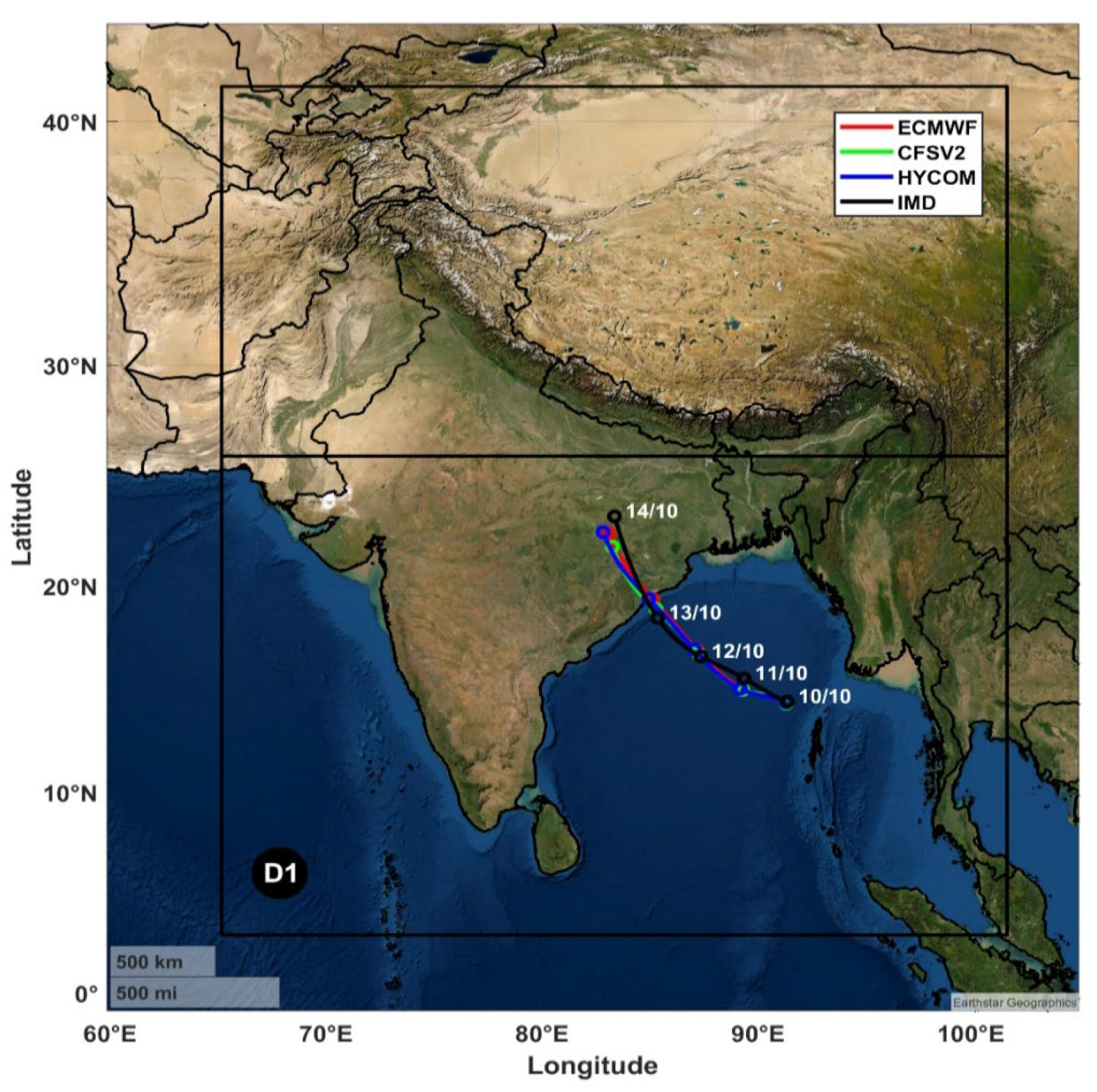
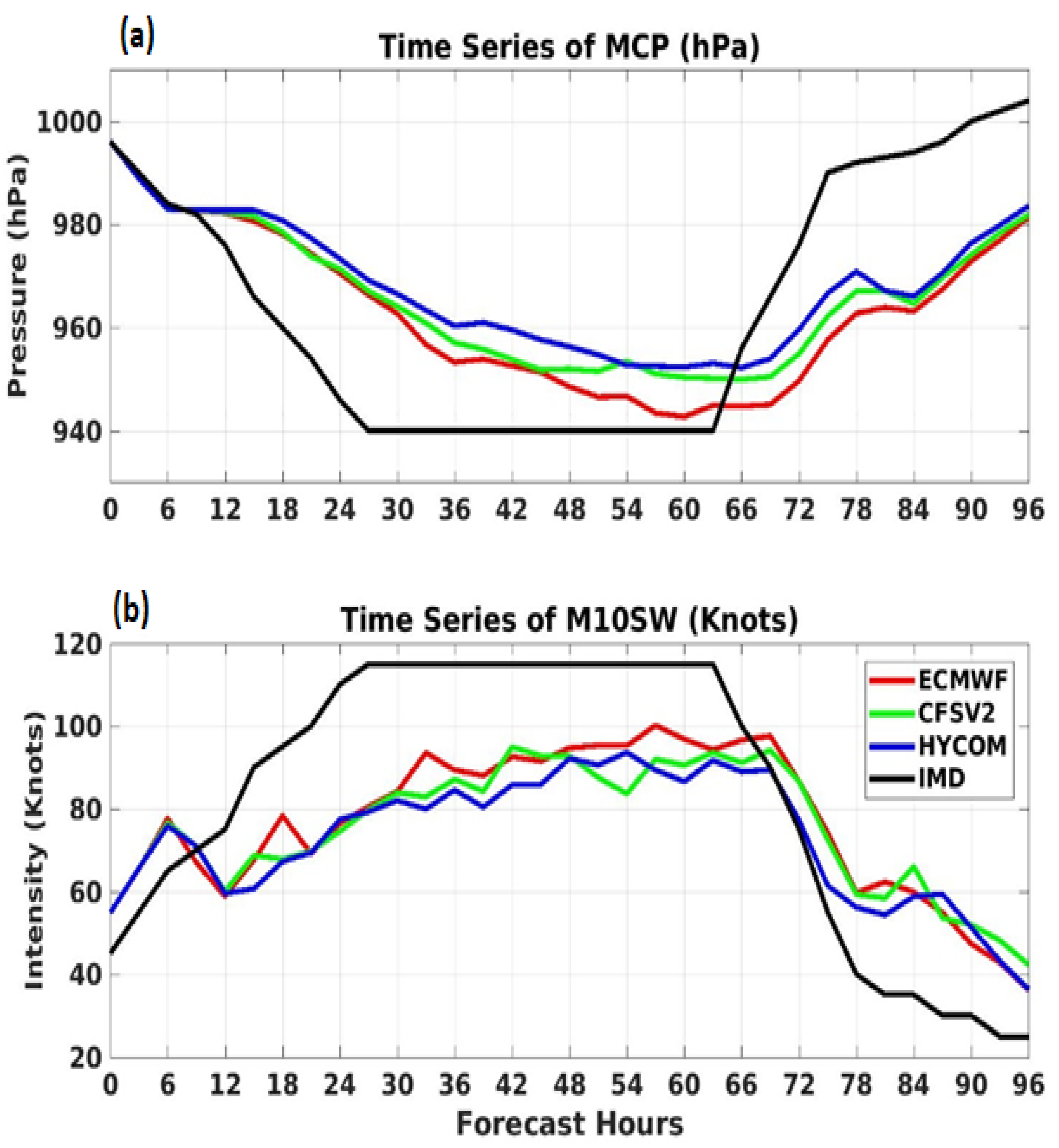
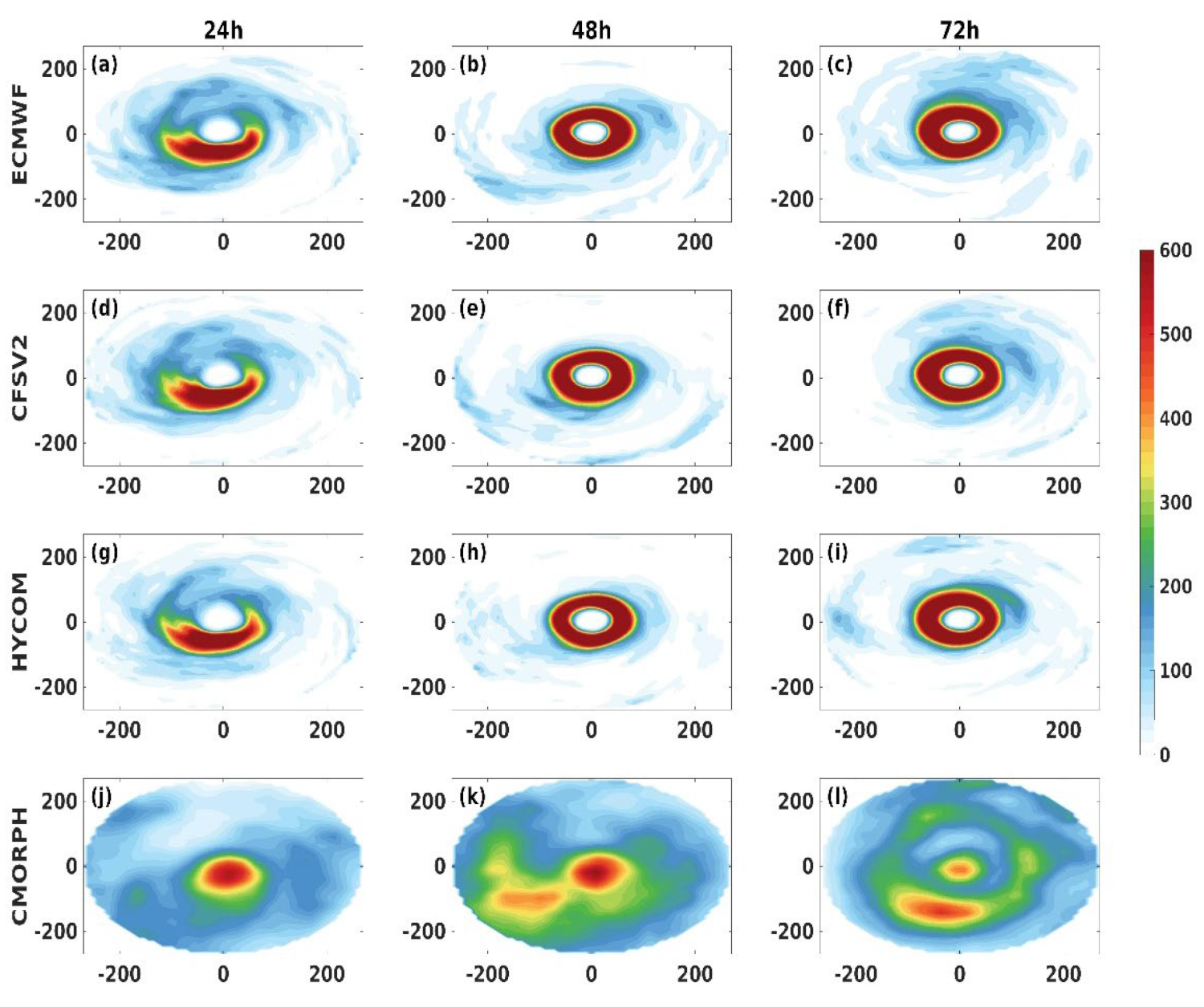
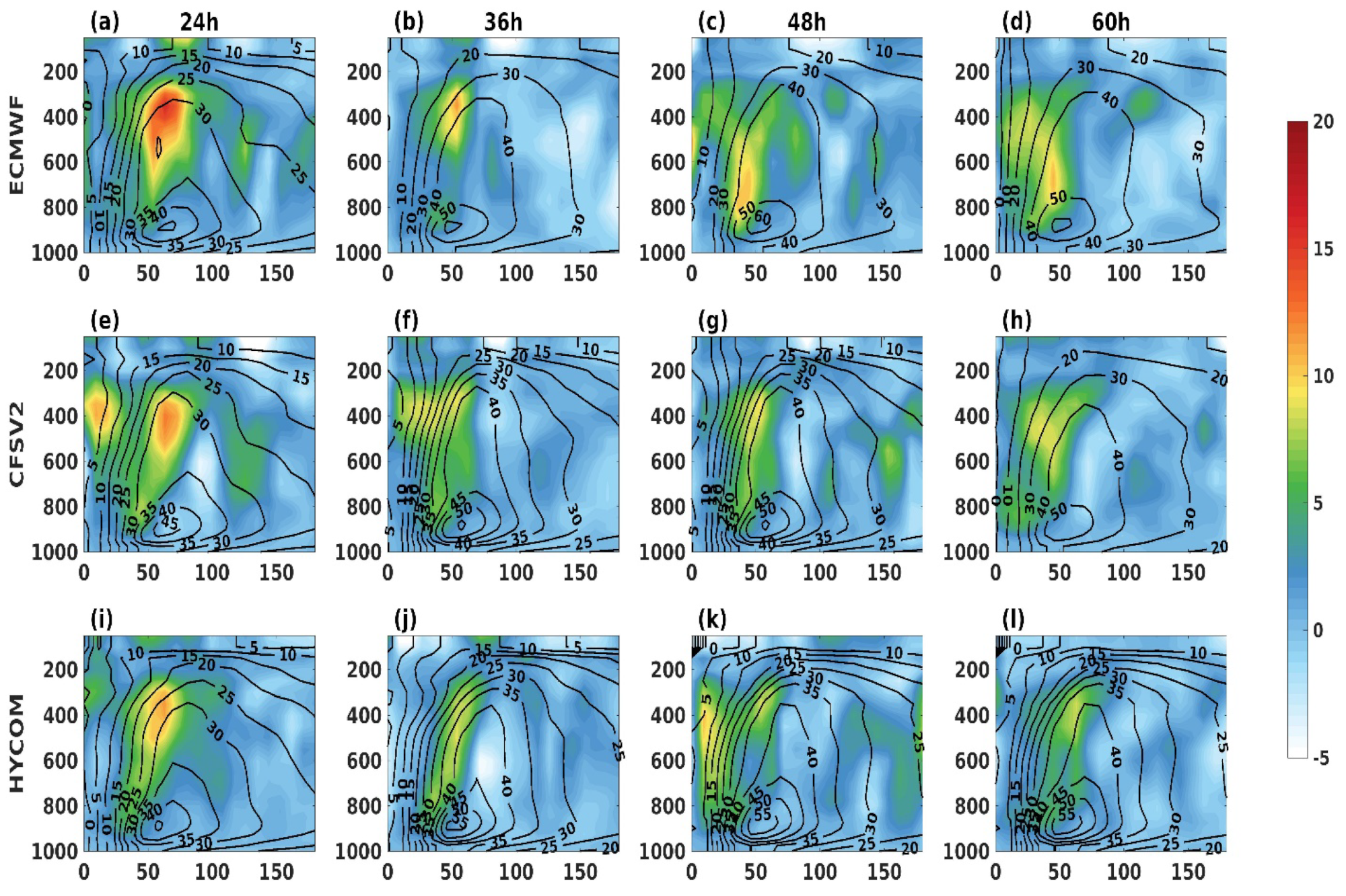
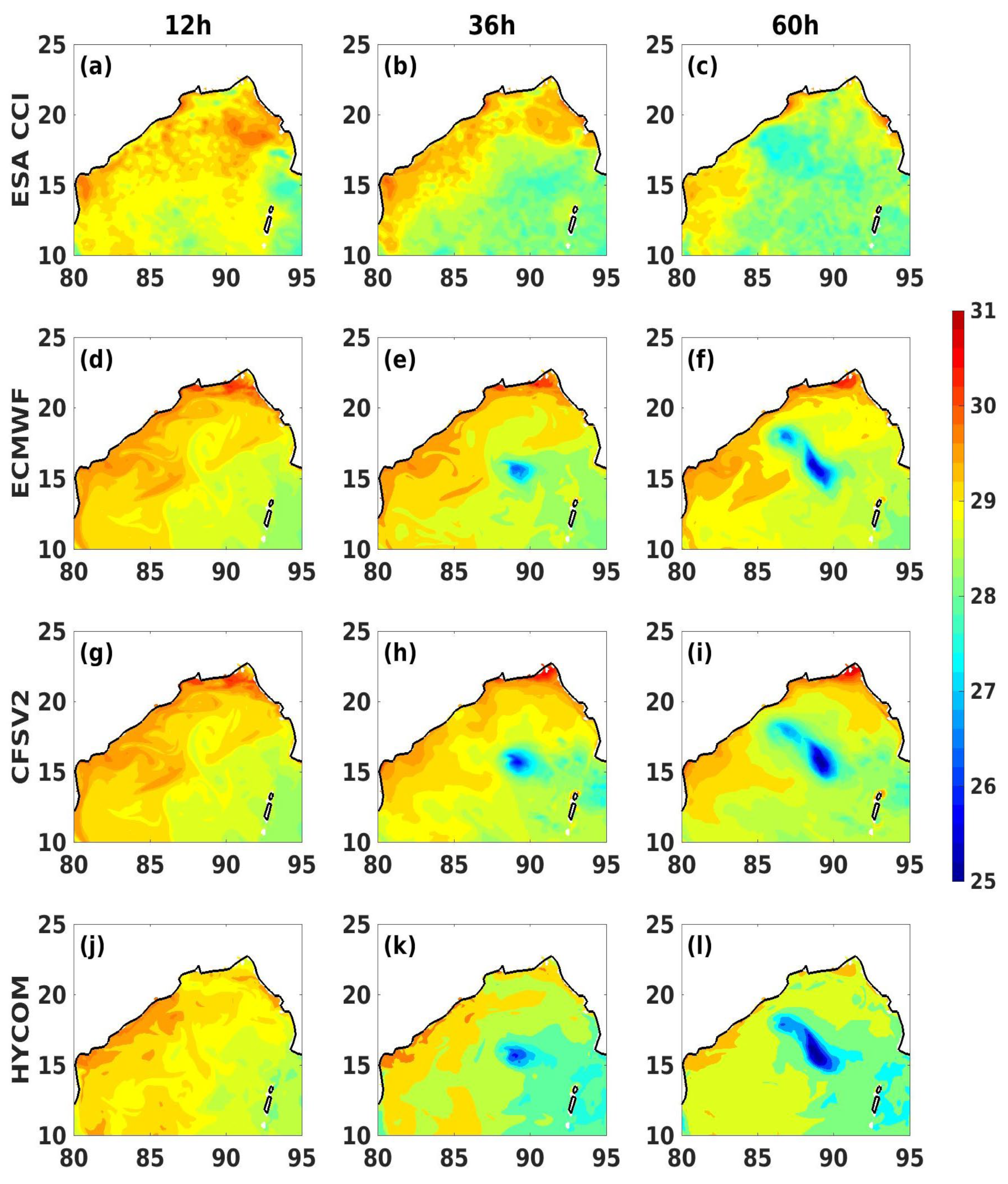
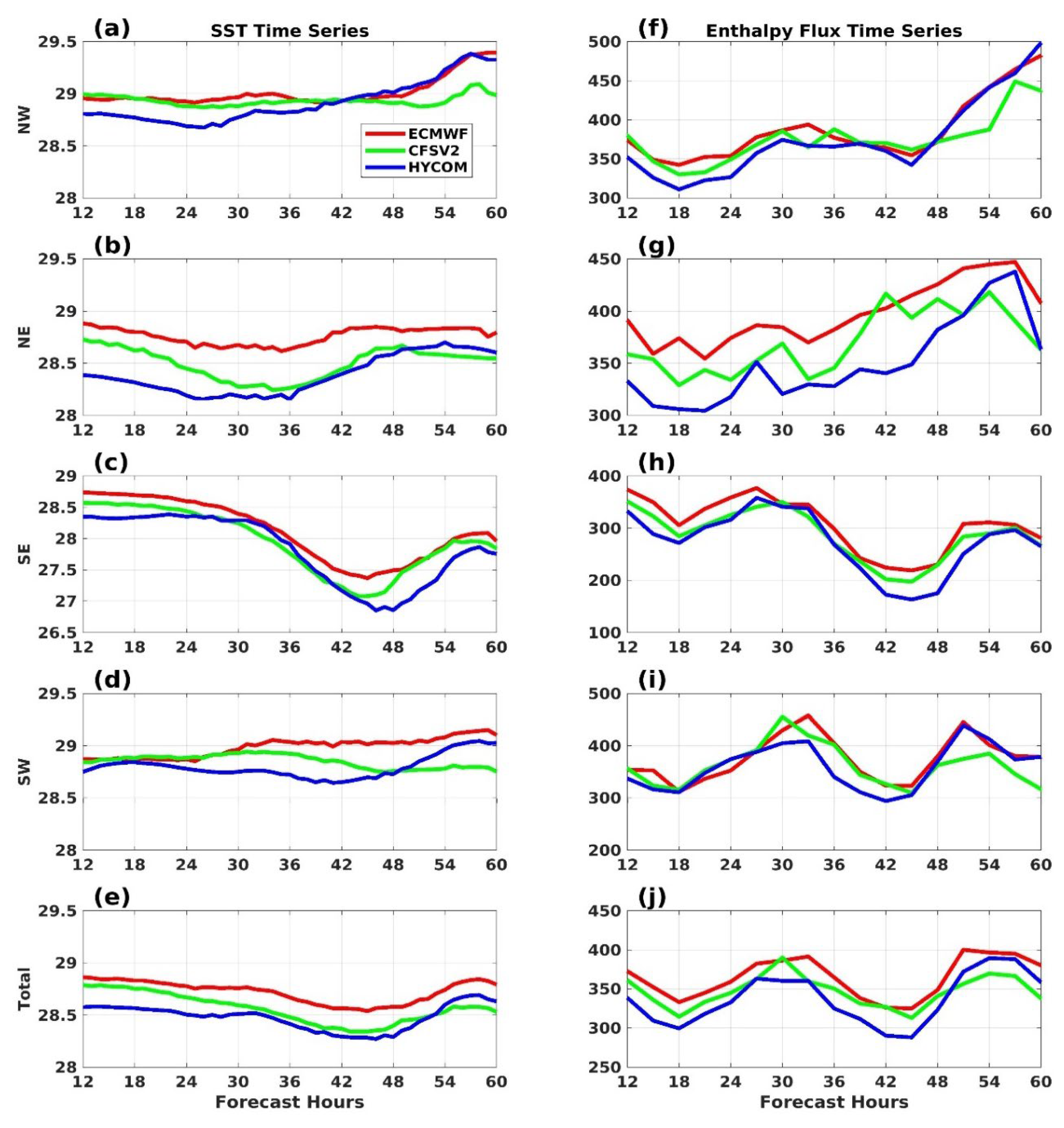
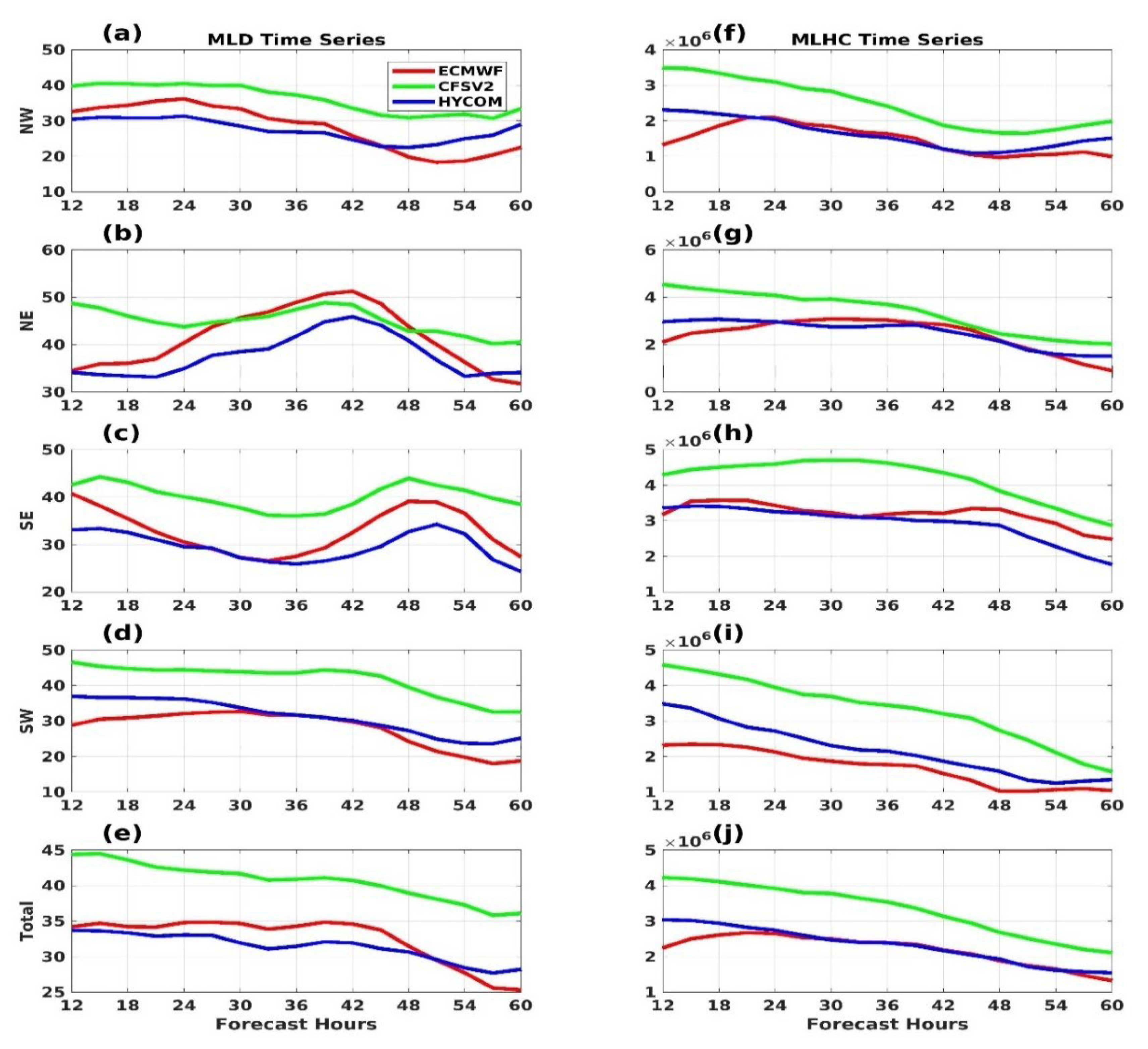

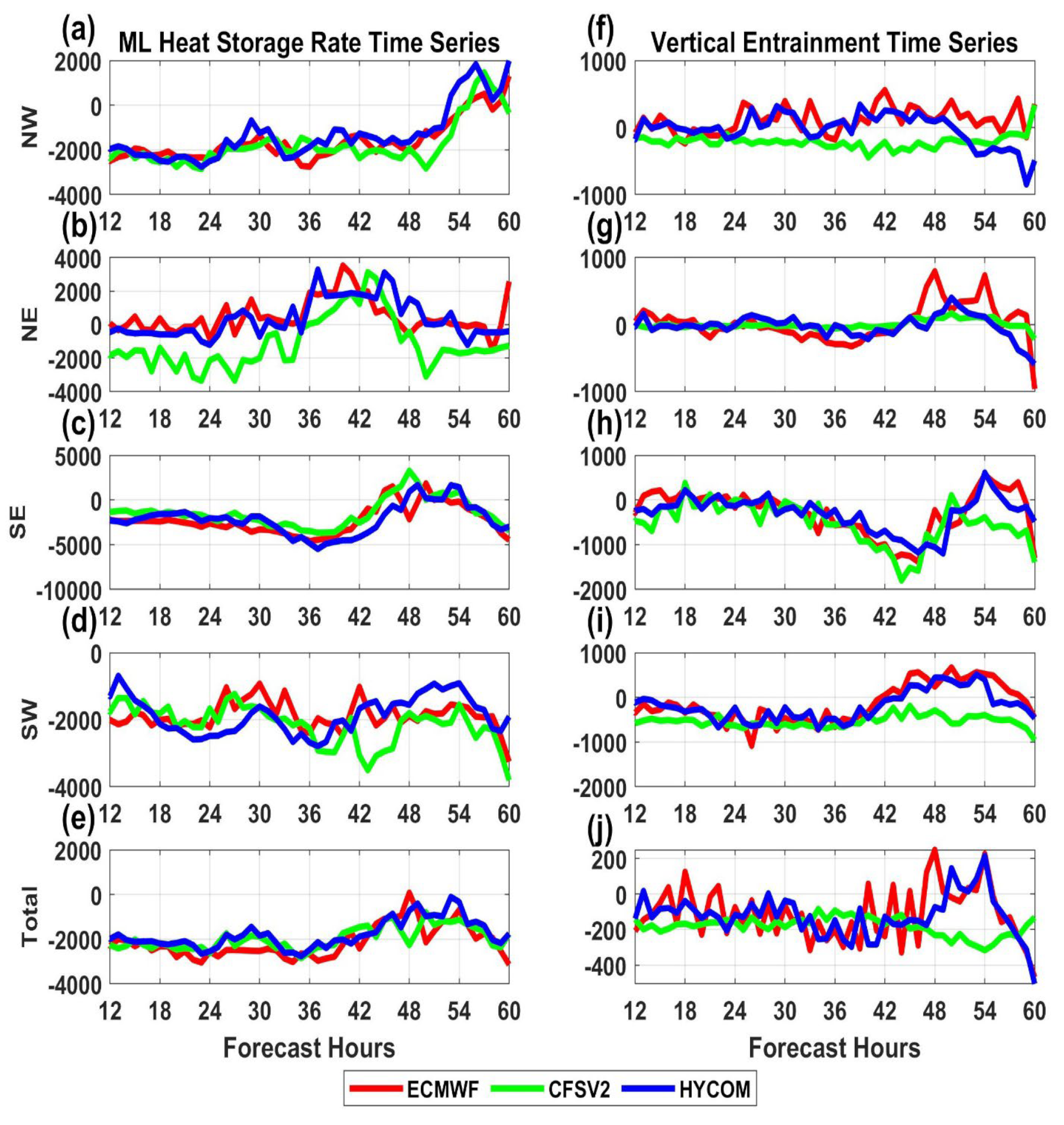
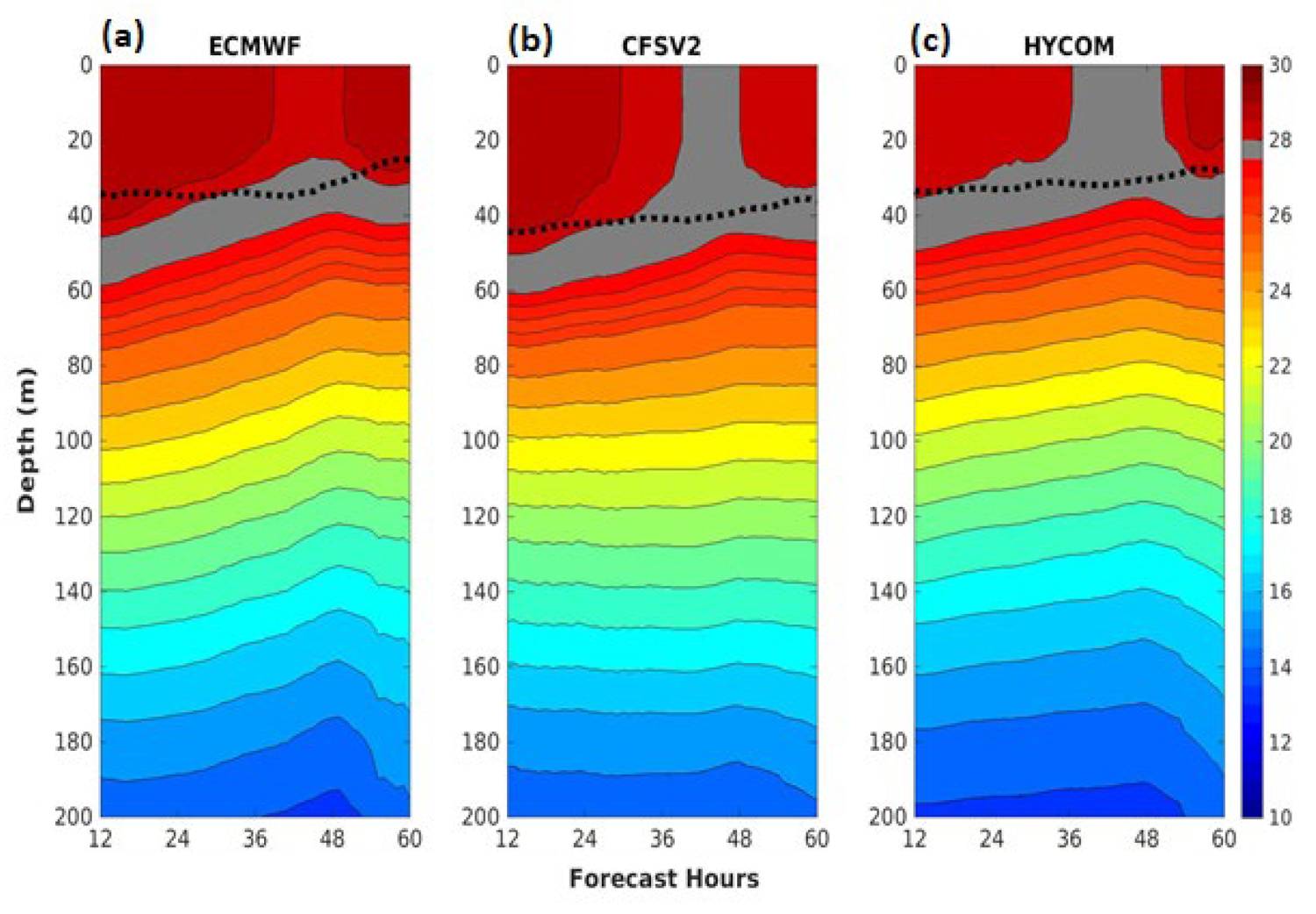
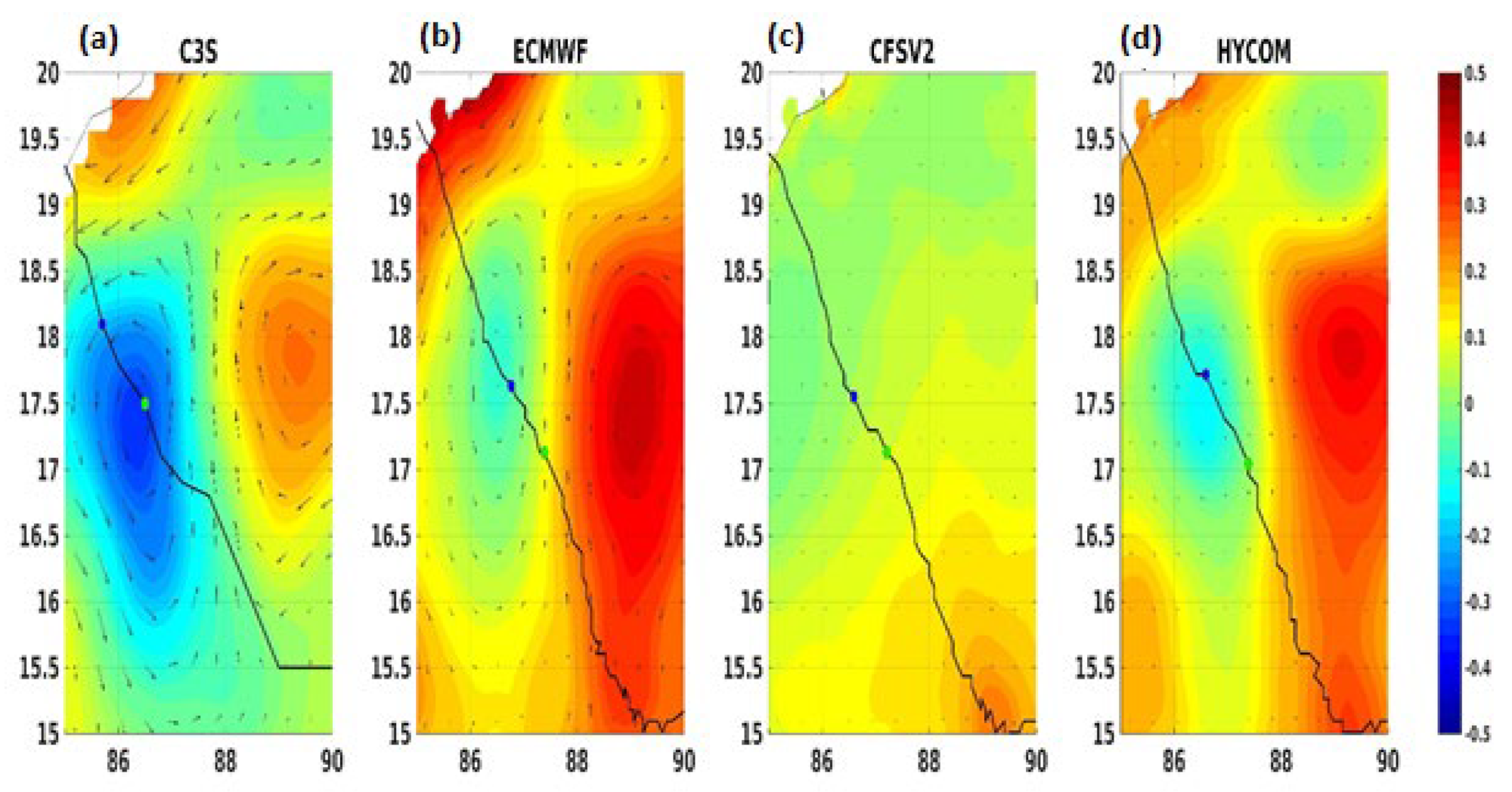
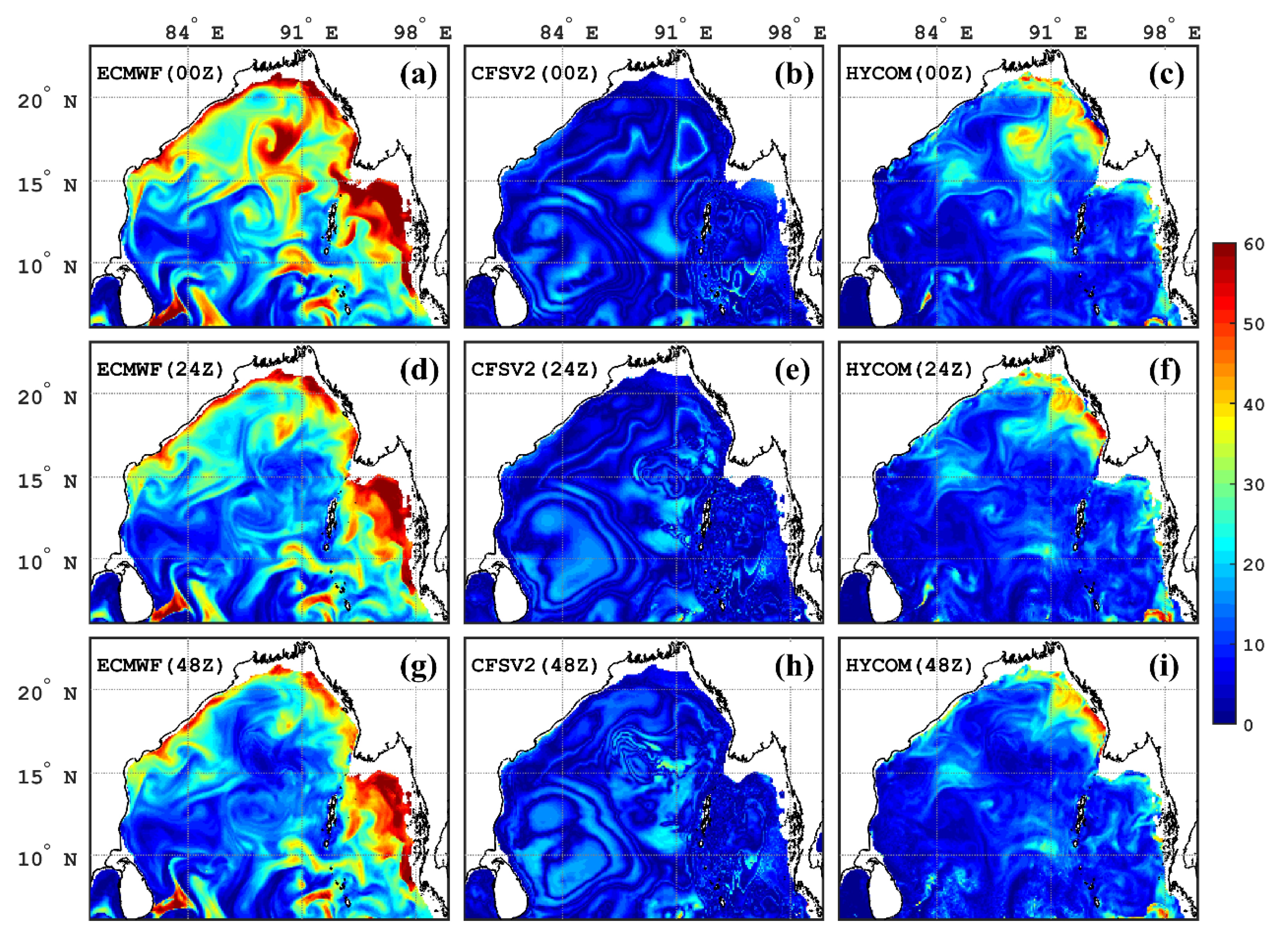

| TC Category | MSSWS in km·h−1 | MSSWS in Knots |
|---|---|---|
| Low Pressure Area (L) | <31 | <17 |
| Depression (D) | 31–49 | 17–27 |
| Deep Depression (DD) | 50–61 | 28–33 |
| Cyclonic Storm (CS) | 62–88 | 34–47 |
| Severe Cyclonic Storm (SCS) | 89–118 | 48–63 |
| Very Severe Cyclonic Storm (VSCS) | 119–165 | 64–89 |
| Extremely Severe Cyclonic Storm (ESCS) | 166–220 | 90–119 |
| Super Cyclonic Storm (SuCS) | >221 | >120 |
| Parameter | Description |
|---|---|
| WRF | |
| Grid Size | 9 km |
| Dimensions (x,y,z) | 414 × 484 × 53 |
| Time Step | 30 s |
| Dynamic Core Option | Eulerian |
| Microphysics | WDM6 Scheme [57] |
| Shortwave Radiation | Goddard Shortwave [58] |
| Longwave Radiation | RRTM Scheme [59] |
| Surface Physics | Monin–Obukhov Scheme [60] |
| Land Surface | Noah Land-Surface Model [61] |
| Boundary Layer | Yonsei University Scheme [62] |
| Cumulus Convection | Kain–Fritsch (New-Eta) Scheme [63] |
| Initial and Boundary Conditions | NCEP FNL Global Analysis [53] |
| Forcing Data Resolution | 1° × 1° (Boundaries Updated Every 6 h) |
| Sea Surface Temperature (SST) | Coupled with ROMS (Updated Every 10 min) |
| ROMS | |
| Grid Size | 9 km |
| Dimensions (x,y,z) | 414 × 274 × 25 |
| Time Step | 30 s |
| Vtransform (Transformation Equation) | 2 |
| Vstretching (Stretching Function) | 4 |
| ӨS (Surface Stretching Parameter) | 6 |
| Өb (Bottom Stretching Parameter) | 0.1 |
| Tcline (Critical Depth) | 200 m |
| Wave Roughness | [64] |
| Wave-Current Stresses | [65] |
| Depth-Averaged Current | [66] |
| Turbulence Closure | [67] |
| Tides | Oregon State University Tidal Database [56] |
| Surface Forcing | WRF |
| Initial and Boundary Conditions | |
| SWAN | |
| Grid Size | 9 km |
| Dimensions (x,y) | 414 × 274 |
| Time Step | 30 s |
| Wave Breaking | Proportionality Coefficient (Alpha = 1) The Breaker Index (Gamma = 0.73) |
| Bottom Friction | [68] |
| Whitecapping | [69] |
| Wave Propagation | Backward Space Backward Time (BSBT) Scheme |
Publisher’s Note: MDPI stays neutral with regard to jurisdictional claims in published maps and institutional affiliations. |
© 2022 by the authors. Licensee MDPI, Basel, Switzerland. This article is an open access article distributed under the terms and conditions of the Creative Commons Attribution (CC BY) license (https://creativecommons.org/licenses/by/4.0/).
Share and Cite
Chakraborty, T.; Pattnaik, S.; Baisya, H.; Vishwakarma, V. Investigation of Ocean Sub-Surface Processes in Tropical Cyclone Phailin Using a Coupled Modeling Framework: Sensitivity to Ocean Conditions. Oceans 2022, 3, 364-388. https://doi.org/10.3390/oceans3030025
Chakraborty T, Pattnaik S, Baisya H, Vishwakarma V. Investigation of Ocean Sub-Surface Processes in Tropical Cyclone Phailin Using a Coupled Modeling Framework: Sensitivity to Ocean Conditions. Oceans. 2022; 3(3):364-388. https://doi.org/10.3390/oceans3030025
Chicago/Turabian StyleChakraborty, Tapajyoti, Sandeep Pattnaik, Himadri Baisya, and Vijay Vishwakarma. 2022. "Investigation of Ocean Sub-Surface Processes in Tropical Cyclone Phailin Using a Coupled Modeling Framework: Sensitivity to Ocean Conditions" Oceans 3, no. 3: 364-388. https://doi.org/10.3390/oceans3030025
APA StyleChakraborty, T., Pattnaik, S., Baisya, H., & Vishwakarma, V. (2022). Investigation of Ocean Sub-Surface Processes in Tropical Cyclone Phailin Using a Coupled Modeling Framework: Sensitivity to Ocean Conditions. Oceans, 3(3), 364-388. https://doi.org/10.3390/oceans3030025






